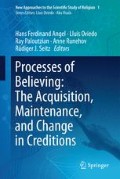Abstract
This paper is concerned with the bearings of recent neuroscientific credition research on David Hume’s influential idea in The Natural History of Religion (1757) that religious belief originates in and is sustained by a fear of misery coupled with mistaken beliefs as to the true causes of happiness. I argue that neuroscientific credition research, in particular of the sort associated with the work of Rüdiger Seitz, Hans-Ferdinand Angel and their colleagues, makes it possible, in principle, to provide some degree of empirical confirmation or disconfirmation for Hume’s idea. However, I also argue that this research is incapable of confirming or disconfirming Hume’s idea conclusively. The upshot of this is that Hume-style accounts of the grounds of religious belief would do well to take this sort of research into account.
Access this chapter
Tax calculation will be finalised at checkout
Purchases are for personal use only
Notes
- 1.
- 2.
For a very different take on Hume ’s aim in the Natural History, see Falkenstein (2003).
- 3.
For example, in a study conducted by Beauregard and Paquette (2006), fifteen Carmelite nuns were asked to recall their strongest experiences of union with God, and in so doing Beauregard and Paquette were able to detect “[s]ignificant loci of activation” in several brain areas, including the left medial prefrontal cortex, the right medial orbitofrontal cortex, and the right middle temporal cortex (Beauregard and Paquette 2006:188). For more on this, see Runehov (2007): 143–151, 173–174, and 2010: 214–215.
References
Addinall P (2001) Philosophy and biblical interpretation. Cambridge University Press, Cambridge
Angel HF (2013) Credition, the process of belief. In: Azari N, Oviedo L, Runehov A (eds) Encyclopedia of sciences and religions, vol 1. Springer, Dordrecht/New York, pp 536–539
Azari N, Nickel J, Wunderlich G, Niedeggen M, Hefter H, Tellmann L, Herzog H, Stoerig P, Birnbacher D, Seitz RJ (2001) Neural correlates of religious experience. Eur J Neurosci 13:1649–1652
Beauregard M, Paquette V (2006) Neural correlates of a mystical experience in Carmelite nuns. Neurosci Lett 405:186–190
Bender F (1968) The natural history of religion by David Hume. Rev Relig Res 10:60–61
Earman D (2000) Hume’s abject failure. Oxford University Press, Oxford
Falkenstein L (2003) Hume’s project in the ‘natural history of religion’. Relig Stud 39:1–21
Feinstein J, Adolphs R, Damasio A, Tranel D (2011) The human amygdala and the induction and experience of fear. Curr Biol 21:34–38
Gaskin JCA (1988) Hume’s philosophy of religion, 2nd edn. Macmillan, London
Hobbes T (2012) Leviathan, vol 2. Clarendon Press, Oxford
Hume D (2000 [1748]) An enquiry concerning human understanding. Clarendon Press, Oxford
Hume D (2007 [1759]) The natural history of religion. A dissertation on the passions. Clarendon Press, Oxford
Hurd R (1757) Remarks on David Hume’s essay on the natural history of religion. Cadell, London
Israel J (2001) Radical enlightenment: philosophy and the making of modernity 1650–1750. Oxford University Press, Oxford
Johnson D (1999) Hume, holism and miracles. Cornell University Press, Ithaca
Kail PJE (2007) Understanding Hume’s natural history of religion. Philos Q 57:190–211
Lowe D, Rogers S (2013) Neuropschology. In: Azari N, Oviedo L, Runehov A (eds) Encyclopedia of sciences and religions, vol 3. Springer, Dordrecht/New York, pp 1500–1508
Mossner E (1980) The life of David Hume, 2nd edn. Oxford University Press, Oxford
Plantinga A (2000) Warranted Christian belief. Oxford University Press, Oxford
Plantinga A (2011) Where the conflict really lies. Oxford University Press, Oxford
Runehov A (2007) Sacred or neural? The potential of neuroscience to explain religious experience. Vandenhoeck & Ruprect, Göttingen
Runehov A (2010) Naturalistic understandings of religious experiences. In: Engberg-Pedersen T, Henrik Gregersen N (eds) Essays in naturalism and Christian semantics. Publications from the Faculty of Theology, Copenhagen, no. 18, pp 201–222
Russell P (2008) The riddle of Hume’s treatise: skepticism, naturalism, and irreligion. Oxford University Press, Oxford
Seitz R, Angel HF (2012) Processes of believing – a review and conceptual account. Rev Neurosci 23:303–309
Thomsen A (1909) David Hume’s natural history of religion. Monist 19:269–288
Author information
Authors and Affiliations
Corresponding author
Editor information
Editors and Affiliations
Rights and permissions
Copyright information
© 2017 Springer International Publishing AG
About this chapter
Cite this chapter
Kraal, A. (2017). Hume on the Origins of Religious Belief. In: Angel, HF., Oviedo, L., Paloutzian, R., Runehov, A., Seitz, R. (eds) Processes of Believing: The Acquisition, Maintenance, and Change in Creditions. New Approaches to the Scientific Study of Religion , vol 1. Springer, Cham. https://doi.org/10.1007/978-3-319-50924-2_15
Download citation
DOI: https://doi.org/10.1007/978-3-319-50924-2_15
Published:
Publisher Name: Springer, Cham
Print ISBN: 978-3-319-50922-8
Online ISBN: 978-3-319-50924-2
eBook Packages: Religion and PhilosophyPhilosophy and Religion (R0)

